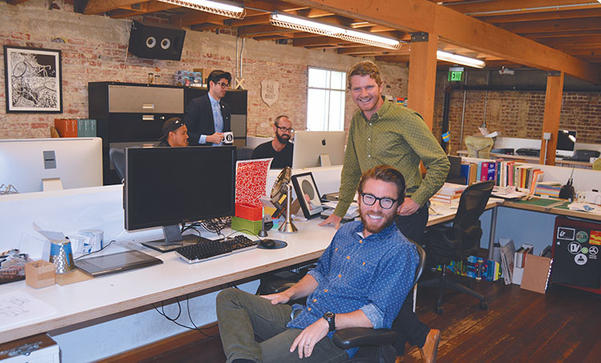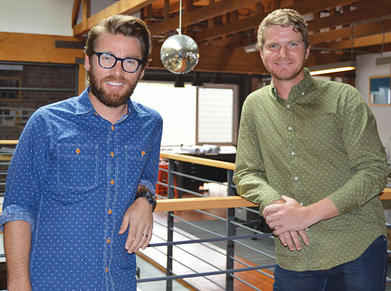It was in the bustling “Mad Men” advertising world of Manhattan’s Madison Avenue that Ryan La Rosa and James Whale, co-founders of local design firm Commune Communications, honed their skills and became friends with a common dream: to escape the bloated bureaucracies of big agencies and start a small firm of their own in a place they could make a real impact.
By way of the heart, they chose Long Beach.
While La Rosa is a Long Beach native and Whale hails from New Zealand, for both, the International City is their chosen home.

Co-founders of Commune Communications Ryan La Rosa, seated, and James Whale, standing at right, began their design firm by cold-calling local businesses and organizations. Their first call was to the Bixby Knolls Business Improvement Association, and ever since, one of their focuses has been working with local business improvement districts. The firm is located in downtown’s East Village. (Photograph by the Business Journal’s Larry Duncan)
“I was born here. My whole family is from here for generations, so we’re Long Beach folk,” La Rosa said. After living in Arizona for a period of time following college, La Rosa and his wife picked up and moved to New York City “for the adventure.” It is there, during his five years working at a major advertising firm, that La Rosa met Whale.
“I ran a small digital agency and was recruited by Ryan’s huge agency to do some stuff for them,” Whale recalled. “We immediately hit it off. I wasn’t ready to move, but we were certainly talking about the idea. I’m a small town guy. I like the beach. . . . So we started talking about the idea of maybe moving to California,” he said.
La Rosa always knew he would move back to Long Beach, but he was surprised to find that Whale was so willing to adopt the city as his own. In fact, as Whale told the Business Journal, he regularly invites his Los Angeles friends to stay in his Belmont Shore home so he can show them the city and convert them to his new hometown. “This is my home now,” Whale said. “I had a conversation on the phone with my mother about a month ago and she said, ‘Are you coming home?’ And I said, ‘No, I think I’m home now.’”
Shortly after the two moved to Long Beach, they started up Commune Communications, which is approaching its two-year anniversary. The business takes its name from a gag Facebook group La Rosa and Whale made while in New York, where they and common friends would fantasize about running away and starting a commune in California.
Whale said the decision to base the business in Long Beach in part had to do with the evolution of the city. “It feels like Long Beach is going through a renaissance right now. There’s a lot of growth, and [we felt] it would be a great place to start a business,” he said.
“We want to be a Long Beach agency. First and foremost, that’s who we are,” La Rosa said. “Our strategy has been [to] take care of home first.”
The two got started by cold-calling potential clients. They began with the city’s business improvement districts – corridors where property or business owners pay a fee to an organization that provides services outside of those the city can offer.
The first person La Rosa and Whale called was Blair Cohn, executive director of the Bixby Knolls Business Improvement Association (BKBIA), which oversees the business improvement district on Atlantic Avenue and Long Beach Boulevard in Bixby Knolls.
“Our strategy was: Blair knows everybody. Do right by Blair and then Blair is going to tell everybody,” La Rosa said.
As with subsequent business districts Commune Communications has worked with, the company provided branding and design expertise to the BKBIA. La Rosa is the firm’s brand strategist, while Whale is the creative director, or as he put it “the coloring-in guy.”
The challenge in creating a unifying brand identity for a business improvement district is that they “have a lot of stakeholders with different sets of needs, different tastes [and] different desires,” La Rosa said. To ensure the final brand identity and the associated design concepts are reflective of everyone in the district, Commune takes an intensive, on-the-ground approach.
“The first thing we do is start to figure out what the problem is,” La Rosa said. Once a problem has been identified, then La Rosa and Whale conduct an “intense research session.” Typically, this involves having an intimate sit-down with a group of stakeholders, which is often the board for the organization, La Rosa explained. Surveys and one-on-one interviews are also sometimes employed.
The Commune team, which includes four other staff members, then develops a strategy that satisfies the competing needs of all the stakeholders in a unified way. “We don’t move forward until everybody agrees and goes, ‘you guys nailed it.’ And that’s hard,” La Rosa said.
Whale said this process removes any subjectivity from the design process. “We’ve proved out that it’s the right color, the right shape or the right slogan for the right reason,” he said. Commune is so focused on strategically led design because, as Whale put it, “Good design on its own is not enough to solve the problem.”
In the case of BKBIA, “while they thought they needed a new logo, what they actually wanted to do was start taking credit for all of the events they’re doing,” La Rosa explained. The association puts on more than a dozen regular events, including First Fridays, Kidical Mass Bike Rides, a supper club and more, he noted.
To solve the issue, Commune developed a branded icon system for the BKBIA. Each event has its own icon. They’re designed uniformly so that eventually, when people see one of the icons, they will automatically associate it with the BKBIA, La Rosa said.
Cohn has since referred Commune to other clients, who have referred them to others – and the business has grown from there. One of those referrals was Kerstin Kansteiner of the 4th Street Business Improvement Association, which oversees the area known as Retro Row.
Like the BKBIA, 4th Street was having some issues developing a unified voice or brand. Each business within the district has a distinct personality. Developing a marketing campaign involved showcasing the diversity within the collective district in a unified way, according to La Rosa.
“We came up with this campaign called ‘I Am 4,’” La Rosa said. In addition to being a social media hashtag and campaign, the concept also appears in the form of decals on 4th Street business windows. “You give them a little marker, and they’ll write ‘I Am 4’ whatever they want to be for: diversity, surfing, good food. It doesn’t matter,” La Rosa explained. “When you walk down the street, each of the businesses are unified in their support and idea in this campaign . . . [that] the notion for 4th Street is the sum of all of the different parts.”

Commune Communications’ Ryan La Rosa, left, and James Whale, pictured at their East Village office, make it a point to develop close, long-term relationships with their design and branding firm’s clientele. (Photograph by the Business Journal’s Larry Duncan)
Business improvement districts typically work with limited resources, Whale noted. For that reason, when Commune works with these districts, the firm creates a set of tools that are ready to use with ease. “Don’t overdesign, don’t stretch it, because if you give them something they can’t use, they’ll fail,” Whale said.
Recently, Commune began working with one of the city’s largest (both in terms of geographical area and budget) districts – Downtown Long Beach. The area is overseen by the Downtown Long Beach Associates, which Commune is helping to rebrand as the Downtown Long Beach Alliance with a new logo and website.
“We haven’t needed to do any SEO or SEM [search engine optimization or marketing], or traditional advertising or marketing,” Whale said of Commune Communications’ growth. “We’ve purely relied on the strength of our work and word of mouth.”
As La Rosa and Whale tell it, the firm’s success is driven not only by the backgrounds of its co-founders but also by its work culture. La Rosa’s background includes work for big names like Toyota, Dos Equis, Odwalla and Adidas. Whale has 16 years of experience and has worked all over the world, including in Berlin, Barcelona, the United Arab Emirates, Australia and other locations.
“It’s an advantage for us that we left and came back, versus sort of staying here and being influenced by our community,” La Rosa said. He and Whale noted that they think it’s important to continue to take time to travel. A recent trip to Alaska led Whale to come up with numerous concepts for their work for the DLBA, for example.
Commune is also focused on long-term relationships with clients, Whale said. “Because of our big agency experience . . . we wanted to create a business where we could in essence pick and choose who we wanted to work with because we wanted to come to work happy and leave happy,” he explained.
“As ambitious and misguided” as the concept of being friends with clients might be, it has worked, La Rosa said. “We’re buddies with most of our clients. We go places. We hang out with them. . . . That’s the kind of company we want to be.”
Locally, Commune Communications has also worked with Councilmember Lena Gonzalez to develop branding for the city’s 1st District, and also recently assisted the Long Beach City Clerk’s office. And while the firm wants to be known for working in Long Beach, a quick look at its list of clientele reveals national names like Taser, PGA, Aflac and many others.
“Honestly, we try not to do much dreaming about the future, because I think it does a disservice to the mission that we’re on in the present,” La Rosa said. “Our idea is to always maintain that we’re a Long Beach agency – a small to midsized shop. Our main focus is to be regarded as the best design firm in Long Beach.”
